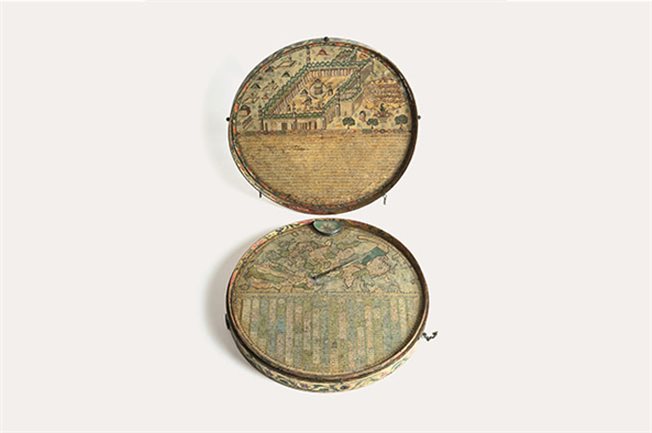Turkey, Istanbul. Dated to 1151 of the Hegira (1738) – painted wood, gold embossed and varnished. Height – 5 cm., diameter – 31.5 cm.
This is a scientific instrument in the shape of a round wooden box, with a needle that points in the direction of the sacred city of Mecca, and a glass-covered compass. An Armenian called el-Baroon invented it in 1730, for the Ottoman grand vizier Yegen Mahmat Pasha. El-Baroon was interpreter of the Flemish representative in Istanbul. The design of the qibla involved connecting a map of Europe with a compass and pointer to a list of countries and cities with their lines of latitude and longitude. The upper part of the box shows a bird’s eye view of the city of Mecca, with the Kabba in the middle. Around the Kabba are four buildings which signify the four schools of Islamic law (Shafiyya, Malikiyya, Hanbaliyya and Hanafiyya), the Maqam Ibrahim, and the holy Well of Zamzam. Other sacred sites visited by pilgrims are described outside the walls, such Safa and Marwa, the Al-Kheif Mosque, Mount Abu Kubeis, Mount Arafat, the Ibrahim Mosque and the Umar Hills. Baab el-Salaam, from the Mecca Gates, is also indicated. On the right, a small decorative framework, with an inscription that with the wish: “He who looks [at the pointer] will be appointed the Grand Vizier.” The bottom part of the box has a map of Europe, Africa and Asia, north of the equator. Below the map there is a list of cities numbered according to their numbers on the map. To find the direction of Mecca from any city the user moves the needle which is connected at one end to Mecca on the map, to the number of the city, and they turn the box until the compass needle points north. When the needle is set, the pointer shows the estimated direction of prayer (in other words, towards Mecca). The last two lines contain the words: “Baroon’s invention.”
